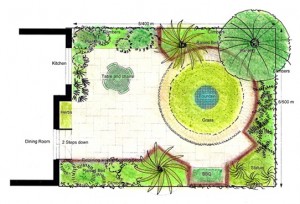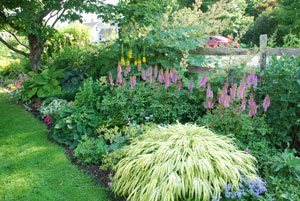
Good garden design starts with thinking about what you want.
Plan your garden before you are in the local garden centre buying every new plant that tempts you.
Spend some time looking at your garden site, either during the winter, when you can really view it objectively or during the growing season, when your successes and failures make themselves known.
Purpose
First work out what you want to use your garden for:-
- Will you be entertaining in or near the garden and need paths or patios?
- Are you looking for privacy from a busy street or neighbours?
- Is this a space small children should be comfortable in?
- Will you be viewing it mostly in the morning, afternoon or evening?
- Is it your own private space or on public view?
- Would you like to attract more birds and butterflies?
- Are you trying to create a view from inside the house?
- Will it be used for cutting flowers?
Look at the site
 Once know how you are going to use your garden, take an objective look at the garden site. Monitor it during different times of the day and year.
Once know how you are going to use your garden, take an objective look at the garden site. Monitor it during different times of the day and year.
How many hours of sun does the site receive?
What times of day is it sunny?
Does sun exposure change with the seasons?
Do trees allow sun in the spring and shade during summer?
How is the soil, as far as pH and texture?
Are there structures or large trees that will affect plant growth and selection?
Are there structures nearby that you would like to camouflage?
What plants are already growing there?
Consider
 There are certain things to be considered before you throw yourself into the fray.
There are certain things to be considered before you throw yourself into the fray.
Do you have a budget?
You may want to plan your garden to be completed in stages.
How much time can you realistically spend in the garden.
How much time needed will vary from season to season.
Are you only in your house for part of the year?
Do you need your garden to peak for a special event?
What Style?

You know what you want to use your garden for, what you are working with and how many resources you can devote to it.
Now, what do you want it to look like?

Formal or informal?
Wild?
Interest in all Four Seasons?
Should it complement your house?
Do you want it to flow with the natural landscape?
Do you prefer soft pastels or bold tropicals?
Will it be a border or a free standing island?
Choosing Plants

Plant selection should be one of the last things you consider, or you may be overwhelmed trying to create a design to accommodate the dozens (or hundreds or even thousands) of plants you crave.
Keep in mind what your garden will be used for and when.
If you are only in your house for the summer, planting spring bulbs and early bloomers wouldn’t be the wisest investment.
If you plan to entertain a lot and don’t want to spend all summer on maintenance, look for easy care plants that don’t require constant deadheading and staking to look good.
If you are planting for small children, choose plants that will bloom at their eye level, with interesting textures and scents and non-poisonous flowers and seeds.
Make a list of the plants you like and group them by colour, texture and form. You could also sort them by season of bloom and/or interest. Consider both flowers and foliage. There are more and more plants being bred with colourful foliage that will provide interest in the garden all season.
 Be sure to include some large plants that will look good all year. These are usually shrubs and often evergreens.
Be sure to include some large plants that will look good all year. These are usually shrubs and often evergreens.
Most gardens can only accommodate 1 or 2 trees or shrubs, but they are important for providing the good bones of the garden and you want to choose wisely at the beginning. Trees and shrubs can be very difficult and heavy to move around.
Then play with your plant list to see what will fit in your garden space and what works well together, given your special circumstances. If you’re too busy in the autumn to do anything other than appreciate the changing colours, plant for autumn foliage colour and avoid plants like asters that will need care in the autumn.
![]()
